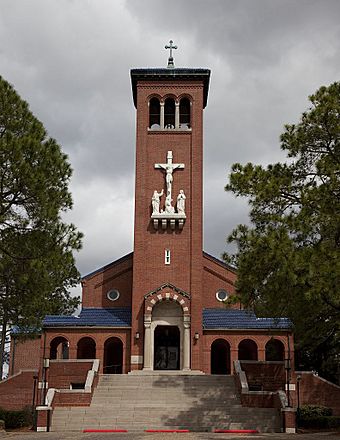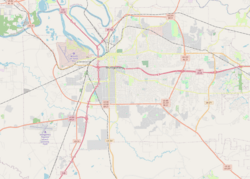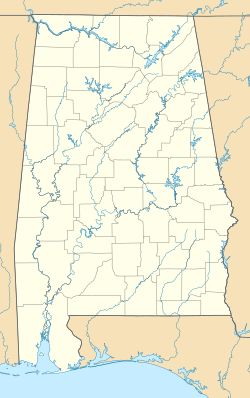City of St. Jude facts for kids
The City of St. Jude is a special place in Montgomery, Alabama. It covers about 36 acres and has been home to a high school, a hospital, and a Catholic church. It was started in 1934 by Father Harold Purcell. His goal was to bring "light, hope and dignity to the poor," no matter their race.
This campus became famous on March 24, 1965. On that night, it hosted the Stars for Freedom rally. Many celebrities came to entertain the tired marchers who were finishing the Selma to Montgomery marches.
The City of St. Jude was added to the National Register of Historic Places in 1990. This means it's recognized as an important historical site. It is also part of the Selma to Montgomery National Historic Trail, which was created in 1996.
Contents
A Look at the Campus
Father Purcell began his work to help African Americans in Alabama through the Catholic Church. He opened a small clinic in a rented house in Montgomery on June 2, 1934. In 1936, he received money from Bishop Thomas Joseph Toolen, who was in charge of the Diocese of Mobile.
With these funds, Father Purcell bought 56 acres of land. He then built a church there, dedicating it to Saint Jude the Apostle in 1938. By that year, the City of St. Jude had already helped 8,000 different patients.
The Church (1938–Present)
The church building was the first main structure built on the campus. It was dedicated in 1938 and has been a central part of the City of St. Jude ever since.
The Social Center (1939–Present)
A social center was built shortly after the church, in 1939. This center was a place for community gatherings and activities. The City of St. Jude plans to create a "Campsite 4 Experience" Museum inside the social center. This museum will share the history of the site.
The School (1947–2014)
The first classes at the City of St. Jude were held in the basement of the 1938 church. The school, called St. Jude Educational Institute, was not officially segregated. This meant it was open to students of all races. Even though Bishop Toolen did not support integration, the early classes had mostly African American students, along with some white students.
During the 25th anniversary of the Selma to Montgomery marches, former Alabama Governor George Wallace stood at the entrance of the St. Jude Educational Institute. He was there to welcome civil rights activists.
The Hospital (1951–1985)
The St. Jude Catholic Hospital opened in 1951. It was very important because it was the first hospital in the southeastern United States that welcomed all patients. It treated everyone, no matter their race or religion.
This hospital is also where Dr. Martin Luther King Jr. and Coretta Scott King's first two children were born. Their names are Yolanda and Martin Luther III. After being shot during the Selma to Montgomery march, activist Viola Liuzzo was taken to this hospital. Doctors tried their best, but sadly, they could not save her. The hospital closed in 1985, but the building was later turned into affordable apartments in 1992.
Stars for Freedom Rally
On the night of March 24, 1965, the final night of the Selma to Montgomery marches, about 10,000 marchers camped at the City of St. Jude. They gathered on an athletic field to watch the Stars for Freedom rally. Many famous people performed on a stage made from empty shipping crates and plywood.
The next morning, about 25,000 people marched from the City of St. Jude towards the Alabama State Capitol building. The line of marchers was so long that the last people didn't reach the Capitol until almost 90 minutes after the leaders.
The pastor of St. Jude asked Bishop Toolen for permission for the marchers to stay overnight. Permission was given, but the Bishop warned of "consequences." After the march, donations to the City of St. Jude dropped a lot. This was because many white Catholic donors supported helping Black people but did not agree with Martin Luther King's methods. Some hospital employees also left, and white students stopped attending the school.
Here are some of the celebrities who were at the Stars for Freedom rally:
- Joan Baez
- James Baldwin
- Ina Balin
- Harry Belafonte
- Tony Bennett
- Leonard Bernstein
- Sammy Davis Jr.
- Billy Eckstine
- Dick Gregory
- Lena Horne
- Mahalia Jackson
- Alan King
- Frankie Laine
- William Marshall
- Johnny Mathis
- Gary Merrill
- The Chad Mitchell Trio
- Odetta
- Peter, Paul and Mary
- Pernell Roberts
- Julius "Nipsey" Russell
- Pete Seeger
- Nina Simone
- Shelley Winters
Lasting Impact
In 2008, the National Park Service suggested that Alabama State University should host the third interpretive center for the Selma to Montgomery National Historic Trail. The City of St. Jude then worked hard to raise money. In 2015, they opened their own interpretive center to share their important history.
Images for kids









